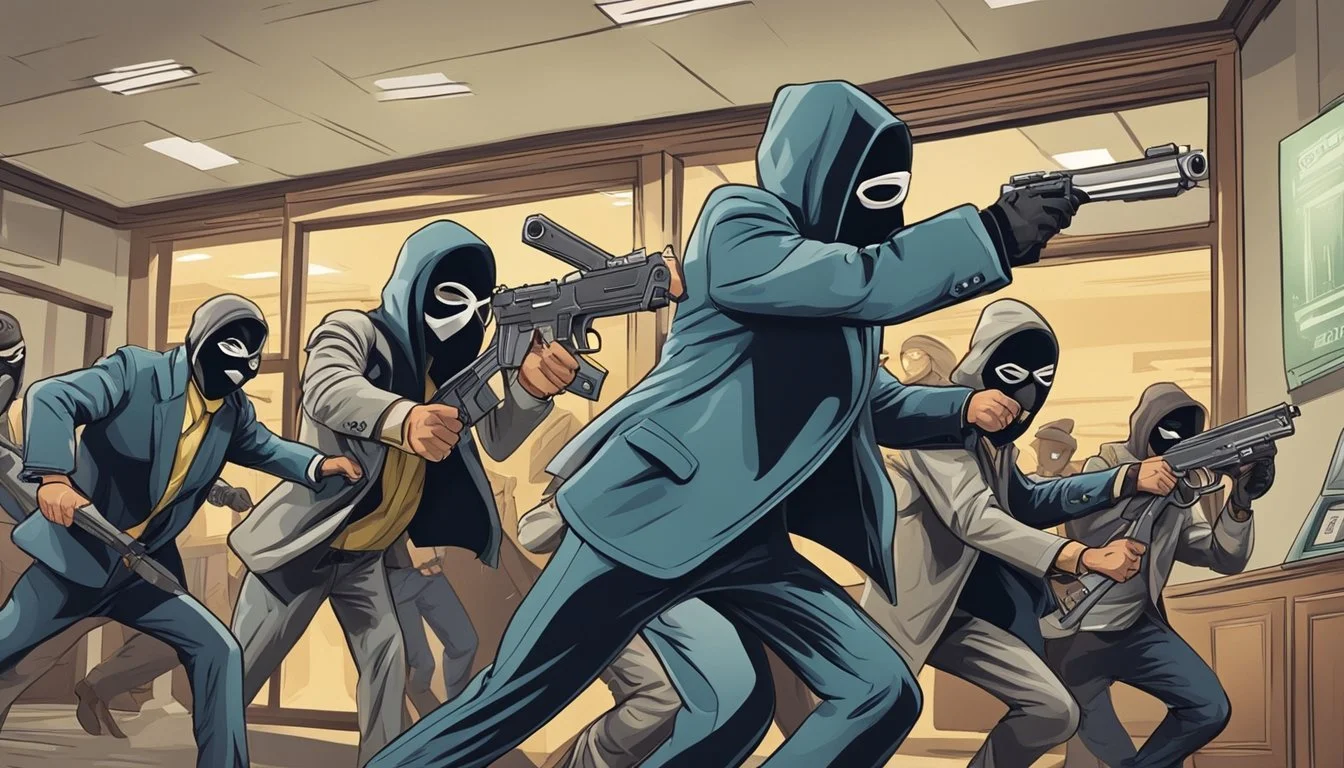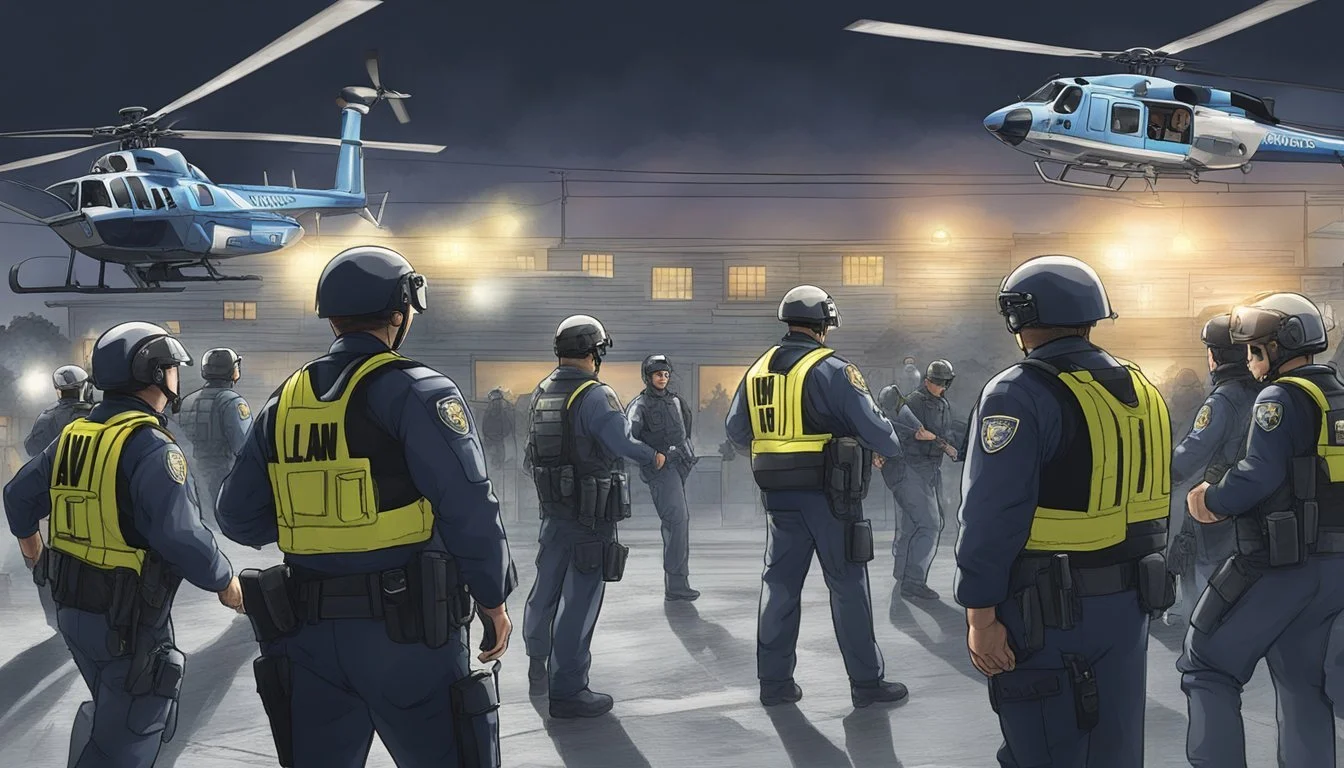6 Gripping Documentaries About Notorious Fugitives and Their Captures
From Manhunts to Justice Served
True crime documentaries captivate audiences with their gripping narratives of real-life criminal exploits. These films offer viewers a glimpse into the minds of notorious fugitives and the relentless efforts of law enforcement to bring them to justice. From daring prison escapes to years-long manhunts, these stories showcase the tension between criminals and those who pursue them.
Documentaries about notorious fugitives and their captures provide valuable insights into criminal psychology, investigative techniques, and the complexities of the justice system. They often feature interviews with key players, archival footage, and expert analysis to create a comprehensive picture of high-profile cases. These films not only entertain but also educate viewers about significant events in criminal history and their impact on society.
1) The Great St. Louis Bank Robbery
"The Great St. Louis Bank Robbery" is a 1959 American heist film based on a real-life bank robbery attempt in 1953. Directed by Charles Guggenheim, the film stars Steve McQueen as a college dropout recruited to be the getaway driver.
The movie takes a documentary-style approach, filming on location in St. Louis and using actual police officers involved in the original case. This lends an air of authenticity to the production.
The plot revolves around a group of inexperienced criminals planning to rob the Southwest Bank, one of the wealthiest banks in Missouri. Their ambitious scheme quickly unravels due to poor execution.
The film explores the impact of the attempted heist on the local community. It depicts the tension and consequences that arise when criminal ambitions clash with small-town life.
While fictionalized, the movie draws heavily from the true events of the 1953 robbery. It serves as both a crime drama and a snapshot of mid-20th century St. Louis.
2) On the Run: The Hunt for James Earl Ray
James Earl Ray became one of America's most notorious fugitives after assassinating civil rights leader Martin Luther King Jr. on April 4, 1968 in Memphis, Tennessee. The FBI immediately launched a massive manhunt, placing Ray on their Ten Most Wanted Fugitives list.
Ray used several aliases to evade capture as he fled across borders. The FBI distributed wanted posters with Ray's photo and details to law enforcement agencies nationwide. They meticulously tracked leads and clues left behind by the killer.
The search for Ray expanded internationally as evidence suggested he had fled the country. After two months on the run, Ray was finally apprehended at London's Heathrow Airport on June 8, 1968. He was attempting to board a flight to Belgium using a false Canadian passport.
Ray was extradited back to the United States to face trial for King's murder. He pleaded guilty and received a 99-year prison sentence. In 1977, Ray briefly tasted freedom again after escaping from Brushy Mountain State Prison in Tennessee with six other inmates.
A two-day manhunt ensued before authorities recaptured Ray. He was returned to prison, where he remained until his death in 1998. The FBI's relentless pursuit of James Earl Ray stands as one of the most famous fugitive hunts in American history.
3) Capture of the Unabomber: Ted Kaczynski
Ted Kaczynski, known as the Unabomber, evaded authorities for nearly two decades while carrying out a series of mail bombings across the United States. His attacks targeted universities and airlines, earning him the FBI code name "UNABOM" (University and Airline Bomber).
Kaczynski's reign of terror began in 1978 and continued until his arrest in 1996. During this time, he killed three people and injured 23 others through his meticulously crafted explosive devices.
The breakthrough in the case came when Kaczynski's 35,000-word manifesto was published in major newspapers. His brother recognized the writing style and alerted authorities, leading to the largest manhunt in FBI history.
FBI agents finally located Kaczynski in a remote cabin in Montana. The former mathematics professor had been living off the grid, rejecting modern technology and society.
Kaczynski's capture marked the end of one of the longest and most expensive FBI investigations in history. His case has been the subject of numerous documentaries, exploring his motivations, methods, and the complex investigation that led to his arrest.
4) Runaway Devil: The Natasha Ryan Case
Natasha Ryan's disappearance in 1998 captivated Australia. The 14-year-old vanished from Rockhampton, Queensland, sparking a massive search effort.
As months passed without leads, authorities suspected foul play. They even charged a local serial killer with her presumed murder.
In a shocking twist, Ryan was found alive in 2003. She had been hiding for nearly five years with her boyfriend, Scott Black, who was 22 years her senior.
The case became known as the "Runaway Devil" due to Ryan's young age and the unusual circumstances of her disappearance.
Ryan's reappearance during the trial of her alleged killer stunned the nation. It raised questions about teenage rebellion, forbidden relationships, and the complexities of missing persons cases.
The documentary explores the events leading to Ryan's disappearance, the impact on her community, and the aftermath of her discovery.
5) The Snakehead: Sister Ping and the Human Trafficking Syndicate
Cheng Chui Ping, known as Sister Ping, ran a notorious human smuggling operation from New York's Chinatown. Her network brought thousands of Chinese immigrants illegally into the United States between 1984 and 2000.
Sister Ping's organization earned her the moniker "Mother of all Snakeheads," with snakehead being criminal slang for human smugglers. Her operation was extensive, reportedly moving up to 200,000 people illegally during its peak.
The smuggling ring's methods were often dangerous for the immigrants. In one tragic incident in 1993, a cargo ship used for human smuggling ran aground in New York, highlighting the perilous nature of these operations.
Sister Ping's reign as a powerful underworld figure came to an end when she was arrested and convicted. She received a 35-year prison sentence for her role in the trafficking syndicate.
The case of Sister Ping shed light on the complex and often deadly world of human smuggling. It exposed the risks faced by desperate immigrants and the profits reaped by those who exploited their circumstances.
Sister Ping died in a Texas prison in 2014, marking the end of a notorious chapter in human trafficking history.
6) The Hunt for Whitey Bulger
James "Whitey" Bulger, a notorious Boston gangster, eluded capture for 16 years before his arrest in 2011. His story became the subject of intense media coverage and multiple documentaries.
Bulger rose to power in South Boston's criminal underworld, becoming one of America's most wanted fugitives. His ability to evade law enforcement for over a decade captivated the public imagination.
The FBI's pursuit of Bulger was complicated by his past as an informant, which raised questions about potential corruption within the agency. This aspect of the case added layers of intrigue to the manhunt.
In 2011, FBI agents finally tracked Bulger to Santa Monica, California. The arrest marked the end of a lengthy and frustrating search that spanned nearly two decades.
The documentary "Whitey: United States of America v. James J. Bulger" by Joe Berlinger explores the trial that followed Bulger's capture. It delves into the accusations of corruption within law enforcement and the legal system surrounding the case.
Understanding Notorious Fugitives
Notorious fugitives captivate public attention through their audacious crimes and ability to evade capture. These individuals often possess distinct traits and emerge from specific historical contexts that shape their actions and pursuits.
Characteristics of High-Profile Fugitives
High-profile fugitives typically exhibit exceptional intelligence and adaptability. They often possess strong survival instincts and a keen ability to blend into new environments. Many are charismatic, enabling them to manipulate others and gain assistance during their time on the run.
These individuals frequently display narcissistic tendencies and a disregard for authority. Their crimes often involve financial fraud, organized crime, or violent offenses. Some notorious fugitives have military or law enforcement backgrounds, giving them tactical advantages.
Technological savvy is increasingly common among modern fugitives. They may use sophisticated methods to conceal their digital footprints and create false identities. Physical disguises and frequent relocation are also standard tactics.
Historical Context of Fugitive Pursuits
The pursuit of fugitives has evolved significantly over time. In the early 20th century, the rise of organized crime led to high-profile manhunts for gangsters like John Dillinger and Bonnie and Clyde. These cases prompted the creation of specialized law enforcement units.
The post-World War II era saw an increase in political fugitives, including Nazi war criminals and Cold War defectors. International cooperation became crucial in these pursuits. The 1970s marked a shift towards global terrorism, with fugitives like Carlos the Jackal gaining notoriety.
Recent decades have witnessed a focus on cybercriminals and white-collar fugitives. The globalization of finance has made it easier for some to hide assets and evade justice across borders. Advanced surveillance technologies and international task forces now play key roles in tracking and capturing these elusive individuals.
The Role of Law Enforcement in Captures
Law enforcement agencies play a crucial part in apprehending notorious fugitives. Their expertise, resources, and dedication are often key factors in bringing criminals to justice.
Techniques in Fugitive Tracking
Modern law enforcement employs a range of sophisticated techniques to track and capture fugitives. Advanced surveillance technology, including facial recognition software and GPS tracking, has become invaluable.
Investigators analyze digital footprints, monitoring social media and online activities. This often provides crucial leads on a fugitive's whereabouts or plans.
Behavioral profiling helps predict a fugitive's next moves. Experts study past patterns and psychological traits to anticipate potential hideouts or actions.
Traditional methods like confidential informants and stakeouts remain effective. These time-tested approaches often complement high-tech tools in successful captures.
Collaboration Across Borders
International cooperation is vital when pursuing fugitives who cross national boundaries. Law enforcement agencies worldwide share intelligence and resources to close net on elusive criminals.
Interpol plays a key role, facilitating communication between police forces globally. Their database of wanted persons helps identify and track fugitives across borders.
Joint task forces bring together expertise from multiple agencies. These teams combine local knowledge with specialized skills to enhance investigative efforts.
Extradition agreements between countries are crucial for bringing fugitives to justice. These legal frameworks enable the transfer of suspects to face charges in the appropriate jurisdiction.






